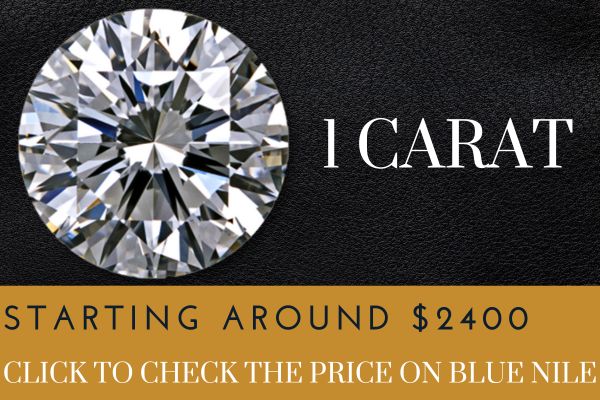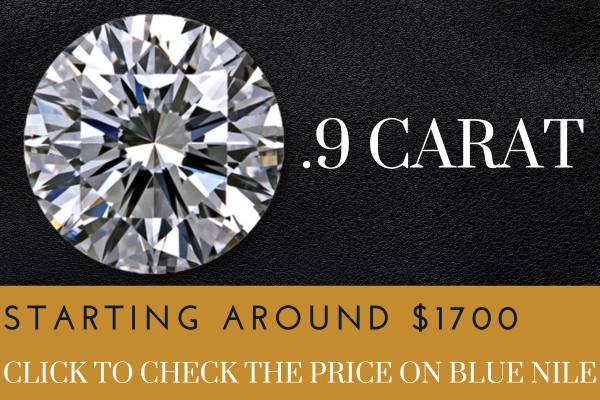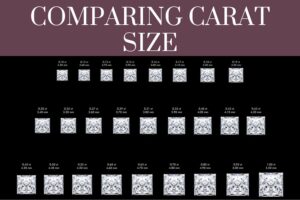
Among the myriad of factors that contribute to a diamond’s allure and value, carat weight holds a significant place. It’s a term that often comes up when discussing diamonds, yet its true understanding goes beyond just the weight.
Carat weight directly influences the size and appearance of a diamond, and subsequently, its price. This makes the task of selecting a diamond with the right carat weight both crucial and challenging. A diamond’s carat can often be a reflection of personal preferences, style, and budget. Hence, understanding the visual impact of different carat weights becomes essential in making an informed decision.
For instance, take a look at this one carat round cut diamond. Our recent search revealed that the starting price for a 1 carat diamond is $2400.
In this guide, we aim to demystify the concept of carat weight and provide a visual comparison to help you comprehend how different carats translate to actual size. The aim is to arm you with the knowledge to find that perfect gem that not only meets your aesthetic desires but also adheres to your budget.
As a seasoned expert in the diamond industry, I have witnessed firsthand the evolution of trends, the sophistication of buyers, and the ever-growing wealth of information available. However, the core principles remain unchanged. The 4Cs – Carat, Cut, Color, and Clarity, continue to be the guiding lights in the journey of choosing the perfect diamond. And among these, carat weight often plays a pivotal role in guiding this choice, making a profound statement of its own.
Decoding Carat Weight: The Keystone of Diamond Selection
The modern-day definition of a carat was standardized in 1907 at the Fourth General Conference on Weights and Measures. Today, a carat is universally accepted to equal 0.2 grams or 200 milligrams.
Carat weight is a straightforward measurement of a diamond’s weight, yet its impact is multifaceted. Unlike the linear measurement of a diamond’s dimensions (in millimeters), the carat weight takes into account the entire volume of the gem. Hence, two diamonds with the same carat weight might appear different in size based on their respective cuts and shapes.
Moreover, the carat weight alone doesn’t define a diamond’s value or beauty; the other three Cs – cut, color, and clarity, play equally crucial roles. However, carat weight is often the first aspect buyers notice due to its direct correlation with the diamond’s size.
The measurement of carat weight is precise to the hundredth of a carat, enabling a meticulous understanding of a diamond’s weight. This precision plays a vital role in the valuation of the diamond, where even a slight difference in weight can result in a significant price disparity. The subtleties of carat weight and its interplay with other factors make the selection of a diamond a nuanced decision, requiring a blend of knowledge, patience, and appreciation for the gem’s inherent beauty.
Visual Comparison of Different Carats: A Closer Look
The carat weight of a diamond is an objective measurement, yet its visual interpretation can be quite subjective. Different carat weights will manifest distinctively based on the diamond’s cut, shape, and even the setting in which it’s placed. A visual guide can be a powerful tool to illustrate these differences, providing a clearer perspective on how carat weight translates to physical size.

Seeing the Size
A 1-carat diamond might seem significantly smaller or larger based on its cut and the proportions of its dimensions. For instance, a 1-carat round diamond could appear quite different in size compared to a 1-carat princess cut diamond, despite having the same carat weight. The visual guide accompanying this section will delineate the variations in appearance for different carat weights across popular diamond shapes.
The Impact of Settings
The setting of a diamond can also influence its perceived size. For instance, a halo setting, which encompasses the center diamond with a circle of smaller diamonds, can make the central stone appear larger. Conversely, a solitaire setting, which features a single diamond, may offer a more accurate representation of the diamond’s size, but with a classic and timeless appeal.
Finger Size and Diamond Carat
The size of the wearer’s finger can also affect the perception of the diamond’s size. A 1-carat diamond may appear more substantial on a size 5 finger compared to a size 8. It’s vital to consider the wearer’s finger size when exploring different carat weights, as this will impact the overall appearance and balance of the ring.
The visual comparison of different carats is an enlightening exercise that unveils the interplay between carat weight, cut, and setting. This understanding is fundamental in making an informed decision, ensuring that the chosen diamond aligns with personal preferences and the aesthetic desire for a harmonious, eye-catching piece.
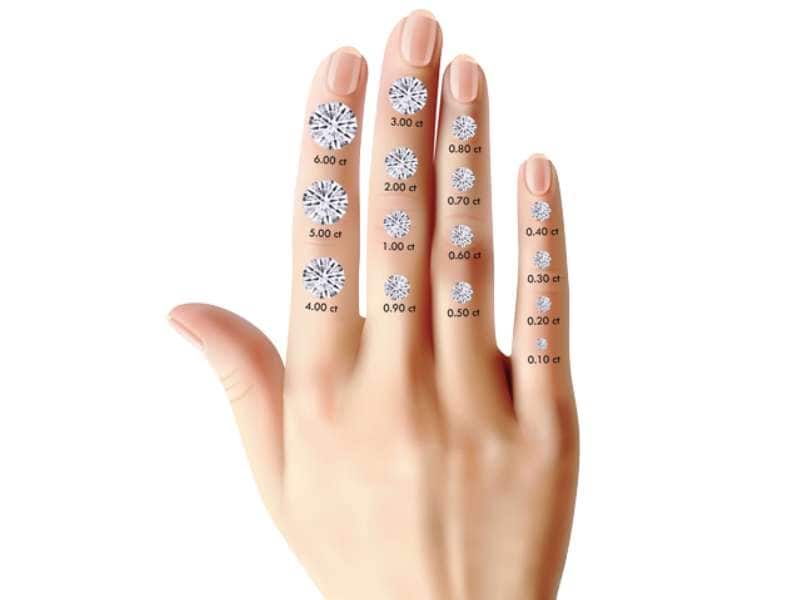
Impact of Carat Weight on Price: The Financial Facet
Price Per Carat Paradigm
The price of a diamond doesn’t increase linearly with its carat weight; instead, it escalates exponentially. For instance, a 2-carat diamond will cost significantly more than twice the price of a 1-carat diamond of similar quality. This is due to the rarity of larger diamonds, making each additional carat exponentially more valuable.
Notable Price Jumps
Significant price jumps are observed at popular milestone carat weights like 0.50, 0.75, 1.00, 1.50, and 2.00 carats. These milestones are often seen as more desirable, pushing their prices higher. It’s a savvy choice to consider purchasing a diamond just shy of these milestone weights, as the price difference can be quite notable. For instance, opting for a 0.90-carat diamond instead of a 1.00-carat diamond can offer significant savings with a minimal difference in size. Similarly, it’s not uncommon for a 0.99-carat diamond to cost substantially less than a 1.00-carat diamond, despite the minuscule difference in size. This approach allows for a balance between achieving the desired aesthetic and managing budget effectively.
Opting for a diamond slightly under a full carat, such as a 0.9 carat, can result in substantial savings without compromising much on the visible size of the gem. For instance, a recent search highlighted a 0.9 carat diamond priced at $1700, while a 1 carat diamond was priced at $2700, showcasing a notable price leap for that extra 0.1 carat. This pricing structure is largely due to the psychological appeal and milestone value associated with a full carat diamond. The minor size difference is often negligible to the naked eye, yet the cost difference is significant, making a slightly smaller diamond a savvy choice for budget-conscious buyers seeking near identical aesthetic appeal at a more affordable price point.
Balancing Budget and Desires
For those with a larger budget, the threshold for acquiring a 2 carat diamond starts around $10,000, as observed on reputable platforms like James Allen. This price point signifies the entry into a realm of greater luxury and prestige in the world of diamonds. While the investment is significantly higher, the allure of a 2 carat diamond, with its enhanced visual appeal and symbolic prestige, often justifies the price for those who can comfortably venture into this budgetary range. It’s a testament to the age-old adage, “you get what you pay for,” reflecting the intertwined relationship between size, quality, and price in the dazzling domain of diamond selection.
Wise Compromises
It’s essential to remember that while carat weight contributes to a diamond’s value, the overall beauty and brilliance of a diamond are determined by a combination of all the 4Cs. Therefore, a smaller, well-cut diamond with excellent clarity and color might be a more prudent choice than a larger diamond of lesser quality.
Choosing the Right Carat Weight for You: A Personalized Approach
Understanding Your Preferences
Every individual has unique preferences when it comes to selecting a diamond. Some may prioritize size, while others may focus on quality. It’s vital to have a clear understanding of your preferences and the significance you place on the carat weight compared to the other 3Cs.
Considering the Setting and Style
The setting and style of the ring can significantly impact how a diamond’s carat weight is perceived. For example, certain settings like the halo or the pave setting can make a diamond appear larger, allowing for a smaller carat weight without compromising on visual impact.
Factoring in Finger Size
The size of the wearer’s finger is a pragmatic factor to consider. Larger carat weights may look more proportionate on larger fingers, while smaller carat weights may suit smaller fingers better. A well-chosen carat weight can enhance the overall harmony and aesthetic appeal of the ring on the finger.
Budgetary Boundaries
Budget is a crucial factor in determining the carat weight you can afford. It’s sensible to set a budget beforehand and explore the best options within that budget. Sometimes, opting for a slightly smaller carat weight or a different cut can provide significant savings while still achieving the desired look.
Comparing Different Diamond Carat Sizes Across Popular Shapes: A Diverse Spectrum
The Round Cut: A Timeless Choice
The round cut is famed for its brilliance and timeless appeal. Comparing different carat sizes in this shape reveals how well it maximizes light return, making even smaller carat weights appear vibrant and full of life.
The Princess Cut: Modern Elegance
Princess cut diamonds offer a contemporary aesthetic. A comparison of carat sizes in this shape showcases its ability to retain weight in the corners, often providing a larger surface area per carat.
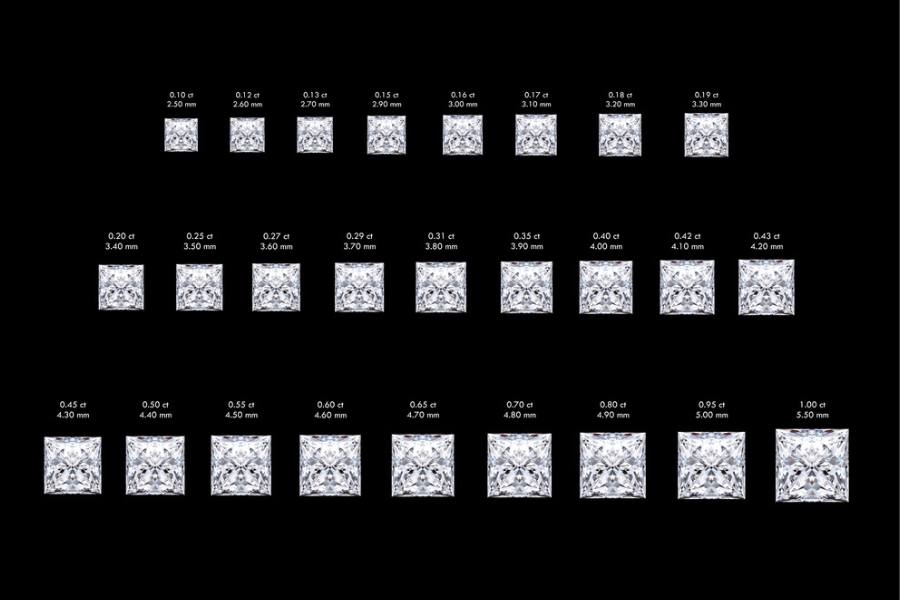
The Oval Cut: Elongated Beauty
Oval cut diamonds are favored for their elongating effect on the finger. Different carat sizes in this shape display varying degrees of this effect, providing a range of options for individual preferences.
The Emerald Cut: Vintage Charm
Emerald cut diamonds exude a vintage charm. A carat comparison in this shape illuminates its unique step-cut faceting, which creates a hall-of-mirrors effect that is enhanced with increasing carat weight.
Crafting Your Perfect Diamond Engagement Ring
Selecting the ideal diamond is a journey of precision, personal taste, and a touch of education on the intricacies of diamonds. The carat weight plays a pivotal role in this journey, influencing not only the appearance but also the price of the diamond. With a thorough understanding of how different carat weights translate visually across various shapes and settings, you can make an informed choice that resonates with your aesthetic and budgetary preferences. At the heart of this endeavor is the aspiration for a diamond that embodies the enduring beauty and symbolic significance of your love.

